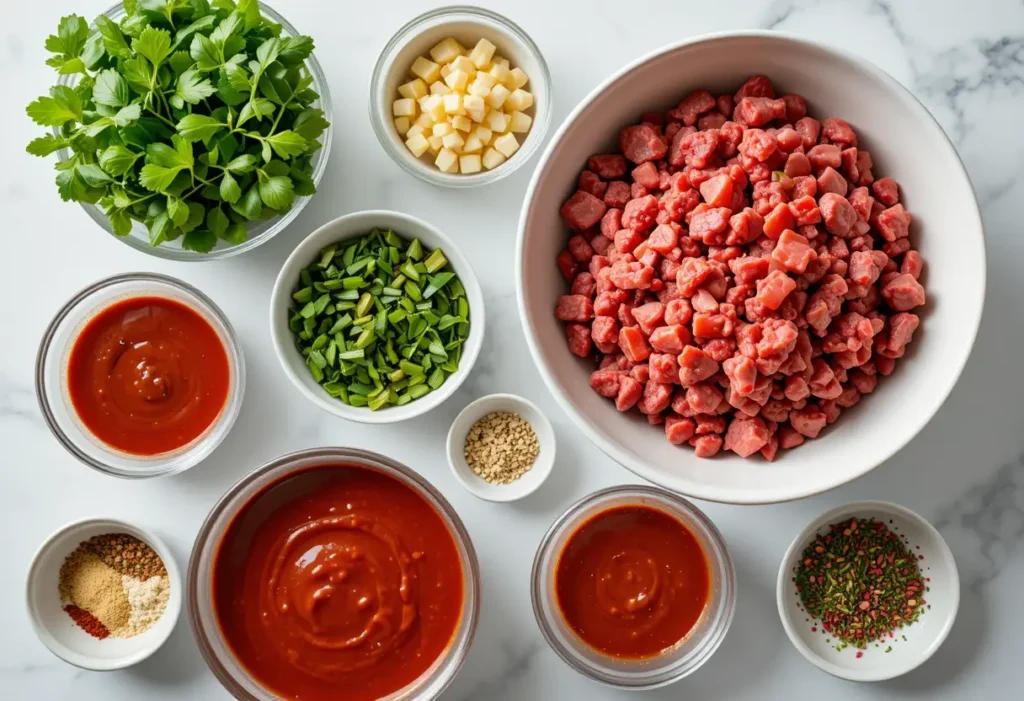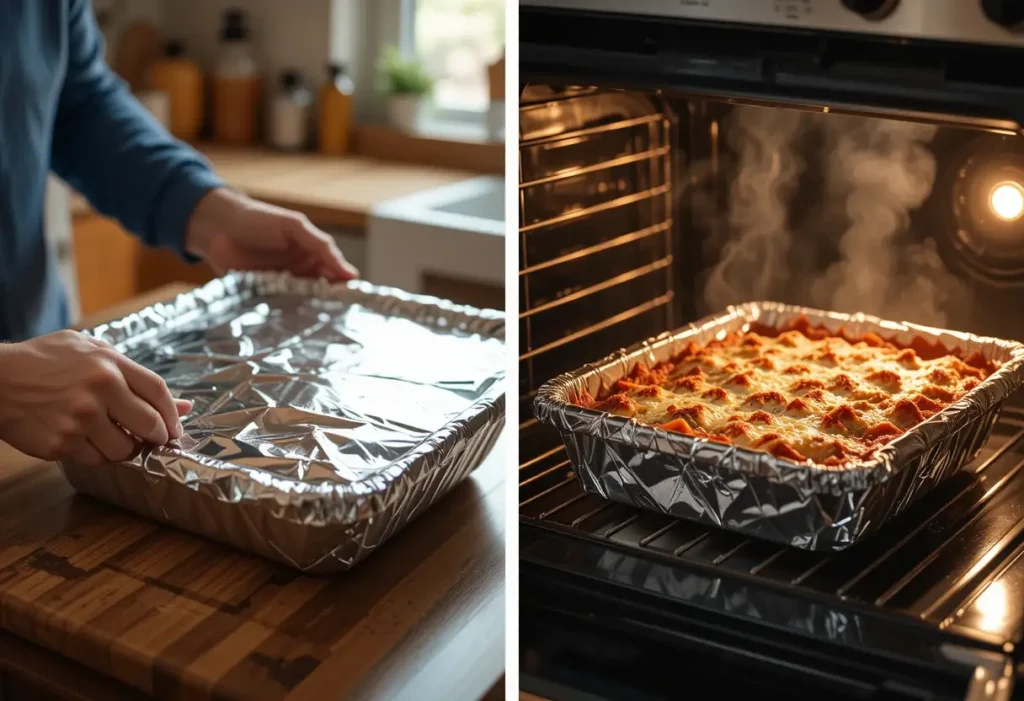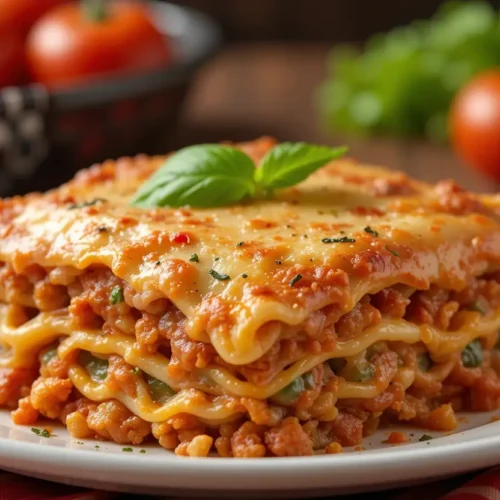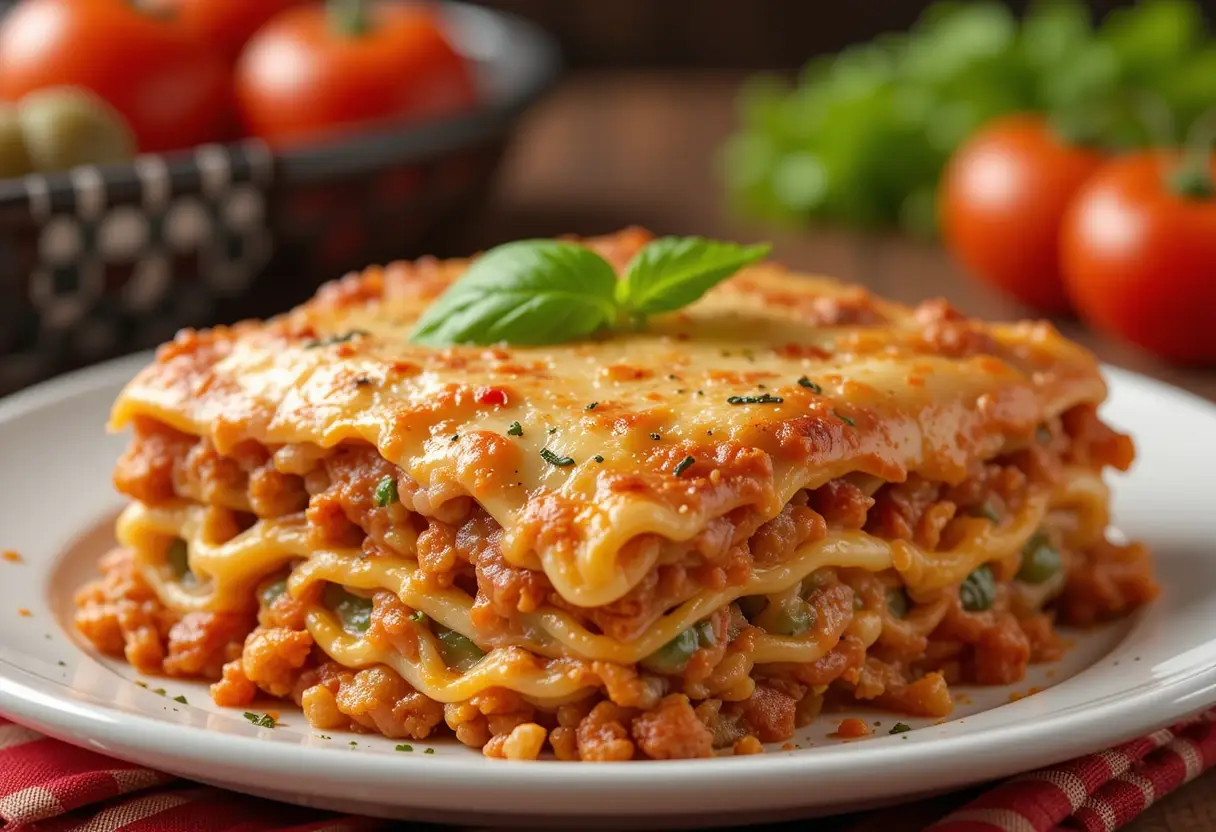Lasagna is the ultimate comfort food, bringing families together over layers of rich, cheesy goodness. Among the many variations of this classic dish, the San Giorgio lasagna recipe stands out as a timeless favorite. Known for its perfect balance of flavors, this recipe features tender pasta sheets, a savory meat sauce, and a creamy cheese blend, all baked to perfection.
Whether you’re cooking for a special occasion or simply craving a hearty homemade meal, this San Giorgio lasagna recipe is sure to impress. Let’s dive into the details and learn how to make this classic Italian dish step by step!
Table of Contents
Ingredients Needed
To create the perfect San Giorgio lasagna, you’ll need a variety of fresh and flavorful ingredients.
Pasta Sheets
- 1 box of San Giorgio lasagna noodles
- 1 tablespoon of salt (for boiling water)
Meat Sauce
- 1 pound ground beef or Italian sausage
- 1 small onion, finely chopped
- 2 cloves garlic, minced
- 1 can (28 oz) crushed tomatoes
- 1 can (15 oz) tomato sauce
- 1 can (6 oz) tomato paste
- 1 teaspoon dried oregano
- 1 teaspoon dried basil
- ½ teaspoon salt
- ½ teaspoon black pepper
- 1 teaspoon sugar (to balance acidity)

Cheese Mixture
- 2 cups ricotta cheese
- 1 egg
- ½ teaspoon salt
- ¼ teaspoon black pepper
- ¼ cup fresh parsley, chopped
Additional Cheese Layers
- 2 cups shredded mozzarella cheese
- ½ cup grated Parmesan cheese
Optional Garnishes
- Fresh basil leaves
- Extra grated Parmesan cheese
Kitchen Tools Required
Before you start cooking, gather the necessary kitchen tools to make the process smooth and efficient.
Essential Kitchen Tools
- Large Pot: To boil the lasagna noodles.
- Strainer: For draining the cooked pasta.
- Large Skillet: To cook the meat sauce.
- Mixing Bowls: To prepare the cheese mixture.
- Baking Dish (9×13-inch): To layer and bake the lasagna.
- Ladle: For spreading sauce evenly.
- Measuring Cups & Spoons: For accurate ingredient portions.
- Aluminum Foil: To cover the lasagna while baking.
Now that we have all the ingredients and tools ready, let’s move on to preparing the lasagna!
Step-by-Step Cooking Instructions
Making San Giorgio lasagna requires a few key steps: preparing the sauce, boiling the pasta, assembling the layers, and baking it to perfection. Follow this detailed guide to create the most delicious homemade lasagna!
Step 1: Preparing the Meat Sauce
- Heat a large skillet over medium heat.
- Add ground beef or Italian sausage and cook until browned, breaking it apart with a spoon. Drain any excess grease.
- Add chopped onions and minced garlic, cooking for another 2–3 minutes until fragrant.
- Stir in crushed tomatoes, tomato sauce, and tomato paste to create a rich base.
- Season with oregano, basil, salt, pepper, and sugar, mixing well.
- Let the sauce simmer for 20–30 minutes, stirring occasionally to develop deep flavors.
Step 2: Boiling the Lasagna Noodles
- Fill a large pot with water and bring it to a boil.
- Add 1 tablespoon of salt to enhance the flavor of the pasta.
- Cook San Giorgio lasagna noodles according to the package instructions, usually 8–10 minutes until al dente.
- Drain the noodles and lay them on a flat surface or parchment paper to prevent sticking.
Step 3: Preparing the Cheese Mixture
- In a mixing bowl, combine ricotta cheese, egg, salt, pepper, and chopped parsley.
- Stir until smooth and well blended.
Step 4: Assembling the Lasagna
- Preheat your oven to 375°F (190°C).
- Spread a thin layer of meat sauce on the bottom of a 9×13-inch baking dish to prevent sticking.
- Place 3-4 lasagna noodles on top, slightly overlapping.
- Spread a layer of ricotta cheese mixture evenly over the noodles.
- Sprinkle a handful of shredded mozzarella cheese and grated Parmesan cheese over the ricotta.
- Add another layer of meat sauce, ensuring full coverage.
- Repeat the layers (noodles, ricotta, mozzarella, meat sauce) until all ingredients are used.
- Finish with a final layer of mozzarella and Parmesan cheese on top.
Step 5: Baking the Lasagna
- Cover the dish with aluminum foil (to prevent excessive browning).
- Bake for 25 minutes covered.
- Remove the foil and bake for an additional 15 minutes until the cheese is bubbly and golden brown.
- Let the lasagna rest for 10-15 minutes before slicing this helps it set for cleaner servings.

Now, your delicious San Giorgio lasagna is ready to serve!
Tips for Perfect San Giorgio Lasagna
Creating the perfect lasagna requires a few expert tips to avoid common mistakes.
1. Avoid Soggy Pasta
Cook the noodles al dente (slightly firm), as they will continue softening while baking. Drain them well and lay them flat to cool to prevent sticking.
For a creative take on lasagna flavors, check out this taco lasagna recipe for a fun twist!
2. Ensure Even Layers
Spread each layer evenly to create a balanced bite. Use a ladle or spatula for smooth sauce distribution, ensuring every bite is packed with flavor.
3. Choose the Best Cheese
Use whole milk mozzarella for a rich, gooey texture. A mix of Parmesan and mozzarella enhances the flavor. For a lighter option, substitute ricotta with cottage cheese.
4. Let It Rest Before Serving
Let the lasagna rest for at least 10 minutes after baking. This allows the layers to set, making it easier to cut neat slices.
Variations of San Giorgio Lasagna
Want to try something different? Here are some creative variations of the San Giorgio lasagna recipe!
1. Vegetarian Lasagna
Swap meat for sautéed mushrooms, zucchini, bell peppers, and spinach. You can use a tomato-based sauce or creamy béchamel for added depth.
If you love vegetarian variations, try this vegetarian lasagna soup for a cozy alternative!
2. Gluten-Free Lasagna
Replace traditional noodles with gluten-free lasagna sheets or thin slices of zucchini or eggplant. Make sure your sauces and seasonings are gluten-free as well.
3. Seafood-Based Lasagna
Substitute ground meat with shrimp, crab, or salmon. A creamy Alfredo sauce works beautifully with seafood. Layer it with ricotta, mozzarella, and Parmesan for extra richness.
4. Spicy Lasagna
Kick up the heat by adding red pepper flakes or chopped jalapeños to the sauce. Spicy Italian sausage is a great substitute for ground beef, and a drizzle of hot sauce before serving adds an extra fiery touch!
Nutritional Information
Lasagna is a hearty, satisfying dish, but it’s important to understand its nutritional breakdown. Below is an estimated nutritional profile for one serving (assuming a 9×13-inch pan serves 8 people).
| Nutrient | Amount per Serving |
|---|---|
| Calories | ~450-500 kcal |
| Protein | ~25g |
| Total Fat | ~20g |
| Saturated Fat | ~10g |
| Carbohydrates | ~45g |
| Fiber | ~5g |
| Sugars | ~8g |
| Sodium | ~700mg |
Healthier Tweaks:
- Use lean ground turkey or chicken instead of beef for lower fat.
- Opt for low-fat ricotta and mozzarella to reduce calories.
- Incorporate whole wheat pasta for added fiber.
Pairing Suggestions
A well-rounded meal enhances the enjoyment of San Giorgio lasagna. Here are some ideal pairings to serve alongside your dish!
Best Side Dishes
- Garlic Bread: The crispy, buttery texture complements lasagna’s softness.
- Roasted Vegetables: Bell peppers, zucchini, and eggplant add a healthy touch.
- Steamed Broccoli or Green Beans: A light, nutritious contrast to the rich dish.
Salad Options
- Classic Caesar Salad: Crisp romaine with Parmesan and croutons balances the lasagna.
- Caprese Salad: Fresh tomatoes, mozzarella, and basil add a refreshing touch.
- Italian Chopped Salad: Romaine, olives, pepperoni, and vinaigrette for a zesty side.
Common Mistakes to Avoid
Even experienced cooks can run into issues when making lasagna. Avoid these common pitfalls for the best results!
1. Overcooking the Pasta
Mistake: Boiling lasagna noodles too long makes them mushy.
Fix: Cook them al dente (slightly firm) since they soften more while baking.
2. Incorrect Layering
Mistake: Stacking ingredients unevenly leads to a messy dish.
Fix: Follow this order: sauce → noodles → ricotta → mozzarella → repeat. Always start and end with sauce!
3. Using the Wrong Cheese
Mistake: Only using mozzarella makes lasagna bland.
Fix: Combine ricotta, mozzarella, and Parmesan for the perfect flavor and texture.
4. Not Letting the Lasagna Rest
Mistake: Cutting into lasagna immediately makes it fall apart.
Fix: Let it rest for at least 10 minutes before slicing to allow layers to set.
Storage and Reheating Tips
Lasagna is a great dish to prepare in advance, and leftovers taste just as delicious—if not better—after a day or two. Proper storage and reheating ensure that your San Giorgio lasagna maintains its flavor and texture.
How to Store Leftovers
Refrigerating Leftovers
If you plan to eat the lasagna within a few days, storing it in the refrigerator is the best option.
- Cool Before Storing : Let the lasagna cool completely before storing to prevent condensation and excess moisture.
- Use an Airtight Container : Transfer leftovers to an airtight container or cover the baking dish tightly with plastic wrap or aluminum foil.
- Storage Duration : Refrigerated lasagna stays fresh for 3 to 5 days.
Freezing Lasagna for Long-Term Storage
If you want to store lasagna for a longer period, freezing is the best option.
- Cut Into Portions : If you do not plan to reheat the entire dish at once, slice the lasagna into individual servings before freezing.
- Wrap Properly : Wrap each portion in plastic wrap, then aluminum foil, or place them in airtight freezer-safe containers. This prevents freezer burn and keeps the flavors intact.
- Label and Date : Write the storage date on the container to keep track of freshness.
- Storage Duration : Properly stored, lasagna can last in the freezer for up to 3 months.
Best Ways to Reheat Lasagna
Reheating in the Oven (Best for Large Portions)
- Preheat the oven to 375°F (190°C).
- Place the lasagna in an oven-safe dish. If frozen, let it thaw in the refrigerator overnight before reheating.
- Cover the dish with aluminum foil to prevent the top layer from drying out.
- Bake for 25 to 30 minutes or until heated through. Remove the foil during the last 5 minutes for a crispy top.
Reheating in the Microwave (Best for Individual Portions)
- Place a lasagna portion on a microwave-safe plate.
- Cover with a damp paper towel to retain moisture.
- Heat on medium power for 2 to 3 minutes, checking and stirring occasionally to ensure even heating.
- If needed, add another minute until fully warmed.
Reheating on the Stovetop (Alternative Method for Quick Reheating)
- Place a slice of lasagna in a skillet over low heat.
- Add a splash of water or sauce to prevent it from drying out.
- Cover the skillet with a lid and heat for 5 to 7 minutes, checking occasionally.
Frequently Asked Questions (FAQs) About San Giorgio Lasagna
1. Can I make lasagna ahead of time?
Yes, lasagna can be prepared one to two days in advance and stored in the refrigerator before baking. Simply assemble the dish, cover it tightly with plastic wrap or foil, and refrigerate. When ready to bake, allow it to sit at room temperature for 30 minutes before placing it in the oven.
2. How do I prevent my lasagna from being watery?
Drain excess fat from cooked meat.
Use a thick, well-simmered sauce.
Avoid overcooking the noodles.
Let the lasagna rest after baking to allow excess moisture to be absorbed.
3. Can I use no-boil lasagna noodles instead of regular ones?
Yes, no-boil lasagna noodles can be used as a time-saving alternative. They absorb liquid from the sauce as they cook, so make sure the sauce is slightly more liquid-based to help soften the noodles properly.
4. What is the best cheese for lasagna?
A combination of ricotta, mozzarella, and Parmesan provides the best texture and flavor. Ricotta adds creaminess, mozzarella provides the classic stretchy texture, and Parmesan enhances the depth of flavor.
5. Can I make a vegetarian version of San Giorgio lasagna?
Absolutely! Replace the meat with sautéed mushrooms, zucchini, spinach, or eggplant. You can also use a plant-based protein substitute or extra cheese for added richness.
6. How do I keep lasagna from sticking to the baking dish?
To prevent sticking, always spread a thin layer of sauce at the bottom of the baking dish before adding the first layer of noodles. You can also lightly grease the dish with olive oil.
Conclusion
San Giorgio lasagna is a classic, comforting dish that is perfect for family dinners and special occasions. With its rich layers of pasta, savory meat sauce, and creamy cheese, it delivers a satisfying homemade Italian meal.
By following the step-by-step instructions and expert tips, you can achieve the perfect lasagna every time. Whether you stick to the traditional recipe or explore variations like vegetarian or gluten-free options, this dish is versatile and crowd-pleasing.
With proper storage and reheating techniques, you can enjoy delicious leftovers without losing flavor or texture. Now, it’s time to gather your ingredients and create a hearty, flavorful lasagna that everyone will love!

Easy San Giorgio Lasagna Recipe to Try Today
Ingredients
- 16 oz San Giorgio® Lasagna noodles
- 1 lb ground beef
- 1 jar 24 oz pasta sauce
- 1½ cups water
- 2 cups ricotta cheese
- 2 cups shredded mozzarella cheese
- ½ cup grated Parmesan cheese
- 2 large eggs
- ¼ cup chopped fresh parsley
- ½ tsp salt
- ¼ tsp freshly ground black pepper
Instructions
- Preheat oven to 350°F (175°C). Cook lasagna noodles according to package instructions; drain and set aside.
- In a large skillet over medium-high heat, brown the ground beef; drain any excess fat.
- Add pasta sauce and water to the skillet with the browned meat; simmer for about 10 minutes.
- In a medium bowl, combine ricotta cheese, 1 cup of mozzarella cheese, Parmesan cheese, eggs, parsley, salt, and pepper.
- Spread about 1 cup of meat sauce on the bottom of an 11×7-inch baking dish.
- Arrange 3 cooked lasagna noodles lengthwise over the sauce; cover with 1 cup of meat sauce.
- Spread half of the cheese mixture over the meat sauce.
- Repeat layers of noodles, meat sauce, and cheese mixture.
- Top with a final layer of noodles and remaining meat sauce; sprinkle with the remaining mozzarella cheese. Cover with foil.
Notes
- Enhance the Sauce: For a deeper flavor, let the meat sauce simmer for at least 30 minutes instead of 10. This allows the flavors to meld and creates a richer, more authentic taste.
- Prevent Watery Lasagna: To avoid excess moisture, drain the ricotta cheese slightly before mixing and let the baked lasagna rest for at least 15 minutes before slicing. This helps the layers set properly.
- Boost the Cheese Topping: For an extra golden and bubbly top, mix the remaining mozzarella with a bit of grated Parmesan and a drizzle of olive oil before baking uncovered in the last 10 minutes.

